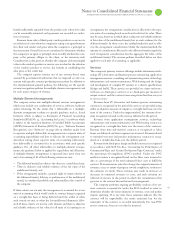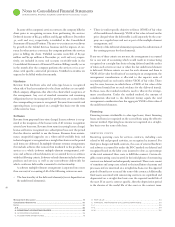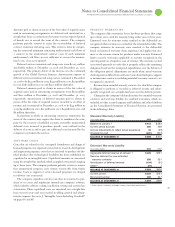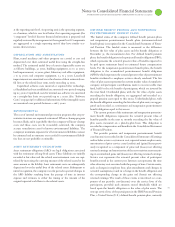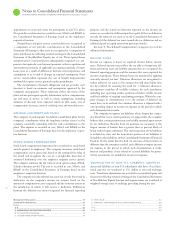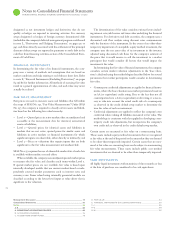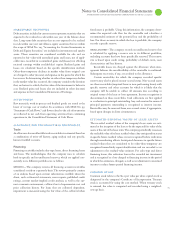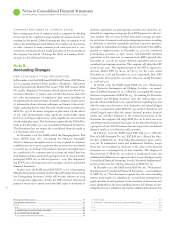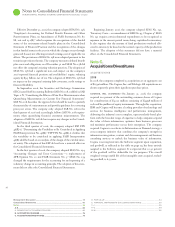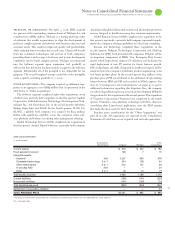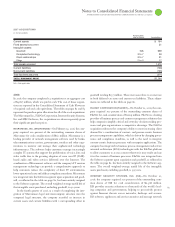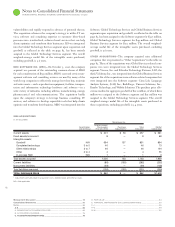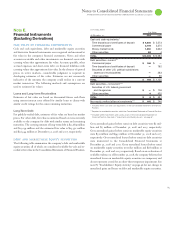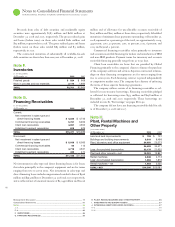IBM 2008 Annual Report Download - page 79
Download and view the complete annual report
Please find page 79 of the 2008 IBM annual report below. You can navigate through the pages in the report by either clicking on the pages listed below, or by using the keyword search tool below to find specific information within the annual report.
Notes to Consolidated Financial Statements
INTERNATIONAL BUSINESS MACHINES CORPORATION and Subsidiary Companies
identify and distinguish between the interests of the controlling and
noncontrolling owners. Pursuant to the transition provisions of SFAS
No. , the company will adopt the Statement on January , via
retrospective application of the presentation and disclosure require-
ments. The company does not expect the adoption of this Statement
to have a material effect on the Consolidated Financial Statements.
In December , the FASB issued SFAS No. (R), “Business
Combinations,” which will become effective in via prospective
application to business combinations. This Statement requires that
the acquisition method of accounting be applied to a broader set of
business combinations, amends the definition of a business combi-
nation, provides a definition of a business, requires an acquirer to
recognize an acquired business at its fair value at the acquisition
date and requires the assets and liabilities assumed in a business com-
bination to be measured and recognized at their fair values as of the
acquisition date (with limited exceptions). The company will adopt
this Statement in fiscal year and its effects on future periods will
depend on the nature and significance of business combinations sub-
ject to this statement.
In September , the FASB finalized SFAS No. which became
effective January , except as amended by FSP FAS - as
pre viously described and FSP FAS - and FSP FAS - as
discussed below. This Statement defines fair value, establishes a
framework for measuring fair value and expands disclosures about fair
value measurements; however, it does not require any new fair value
measurements. On January , , the provisions of this Statement
were applied prospectively to fair value measurements and disclosures
of (a) financial assets and financial liabilities and (b) nonfinancial
assets and nonfinancial liabilities which are recognized or disclosed at
fair value in the financial statements on a recurring basis (at least
annually). The adoption of this Statement did not have a material
effect on the Consolidated Financial Statements for fair value mea-
surements made for the year ended December , . See note D,
“Fair Value,” on page for additional information.
In February , the FASB issued FSP FAS -, “Application
of FASB Statement No. to FASB Statement No. and Other
Accounting Pronouncements That Address Fair Value Measurements
for Purposes of Lease Classification or Measurement under Statement
”. FSP FAS - removed leasing from the scope of SFAS No. .
In October , the FASB issued FSP FAS -, “Determining the
Fair Value of a Financial Asset When the Market for That Asset is
Not Active”. FSP FAS - clarified the application of SFAS in
a market that is not active and provided an example to illustrate key
considerations in determining the fair value of a financial asset when
the market for that financial asset is not active. FSP FAS -
became effective immediately upon issuance, and its adoption did not
have an effect on the Consolidated Financial Statements.
In February , the FASB issued SFAS No. , “The Fair Value
Option for Financial Assets and Financial Liabilities, Including an
amendment of FASB Statement No. ,” which became effective
January , . SFAS No. permits entities to measure eligible
financial assets, financial liabilities and firm commitments at fair
value, on an instrument-by-instrument basis, that are otherwise not
permitted to be accounted for at fair value under other generally
accepted accounting principles. The fair value measurement election
is irrevocable and subsequent changes in fair value must be recorded
in earnings. The company adopted this Statement as of January ,
but has not applied the fair value option to any eligible assets or
liabilities. Thus, the adoption of this Statement did not affect the
Consolidated Financial Statements.
In the first quarter of , the company adopted SFAS No. ,
“Accounting for Servicing of Financial Assets — an amendment of
FASB
Statement No. ,” that provides guidance on accounting for
sepa
rately recognized servicing assets and servicing liabilities. In accor-
dance
with the provisions of SFAS No. , separately recognized
servicing assets and servicing liabilities must be initially measured
at fair value, if practicable. Subsequent to initial recognition, the
company may use either the amortization method or the fair value
measurement method to account for servicing assets and servicing
liabilities within the scope of this Statement. The adoption of this
Statement did not have a material effect on the Consolidated
Financial Statements.
On January , , the company adopted SFAS No. ,
“Account ing for Certain Hybrid Financial Instruments — an amend-
ment of FASB Statements No. and ,” which permits fair value
remeasurement for any hybrid financial instrument that contains an
embedded derivative that otherwise would require bifurcation in
accordance with the provisions of SFAS No. , “Accounting for
Derivative Instruments and Hedging Activities.” The adoption of this
Statement did not have a material effect on the Consolidated Finan-
cial Statements.
The company adopted FASB Interpretation No. , “Accounting
for Uncertainty in Income Taxes — an Interpretation of FASB
Statement No. ” (FIN ) on January , . FIN clarifies the
accounting and reporting for uncertainties in income tax law. This
Interpretation prescribes a comprehensive model for the financial
statement recognition, measurement, presentation and disclosure of
uncertain tax positions taken or expected to be taken in income tax
returns. The cumulative effect of adopting FIN was a decrease in
tax reserves and an increase of $ million to the January ,
retained earnings balance.


